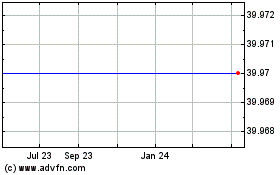By Alexander Osipovich
Regulators have given the green light to a startup exchange that
wants to attract individual traders to the risky world of
futures.
The Small Exchange, a venture led by a former executive of TD
Ameritrade Holding Corp., won approval from the Commodity Futures
Trading Commission on Tuesday to become the newest U.S. futures
exchange.
The CFTC's decision comes as fallout from the coronavirus
epidemic has sent futures markets into a stretch of wild
volatility, with oil futures suffering their steepest one-day drop
in decades on Monday and S&P 500 futures smacking into their
daily 5% price-move limit -- a rare occurrence -- twice this
week.
The Small Exchange would let traders place bets on such moves.
Although established futures exchanges such as CME Group Inc. and
Intercontinental Exchange Inc. can be used by retail traders, too,
they have historically been dominated by large participants such as
banks, energy companies and commodity trading firms.
Futures are contracts that traders can use to bet on whether a
particular market -- such as oil, gold or U.S. stocks -- will go up
or down. One reason they haven't traditionally been used by
individuals is because a bet that goes badly can cause a trader to
lose more money than he or she invested in the first place,
potentially leading to bankruptcy.
Trading futures "is a volatile, complex and risky venture that
is rarely suitable for individual investors," the CFTC warns on its
website.
Donald Roberts, president and chief executive of the Small
Exchange, expects his customers to be sophisticated day traders,
rather than mom-and-pop investors. Still, he says the Small
Exchange won't hide the risks of trading futures.
"We're going to have a concerted effort to educate the public
about the risks of our products," said Mr. Roberts, who previously
oversaw TD Ameritrade's futures and foreign-exchange business.
The Small Exchange faces an uphill battle. Previous efforts to
build new futures exchanges from scratch have often failed to gain
traction.
Adding to the challenges, Chicago-based exchange giant CME has
made a push recently to attract day traders, although they remain a
tiny slice of its business. In 2016, CME began airing a TV
commercial that shows a cheerful dad touting the benefits of
futures trading. Last year, CME launched a bite-size version of its
flagship stock-index futures geared for individuals, who can't bet
as much money as institutional customers.
"The biggest problem that the Small Exchange could have is that
they'd invite CME to take notice and start competing with them,"
said Neal Wolkoff, an exchange-industry consultant and former
executive at the New York Mercantile Exchange, which was acquired
by CME in 2008.
CME is the world's largest exchange operator by market value,
with revenue of $4.9 billion last year. It has a history of
quashing competitors that make runs at its business. A CME
spokesman declined to comment.
Based in Chicago, the Small Exchange hopes to launch in April.
It plans to offer futures linked to oil, the U.S. dollar, stocks,
the yield on 10-year U.S. Treasury notes and precious metals.
As the Small Exchange's name suggests, its contracts will be
smaller in dollar value than the best-known contracts at
established futures exchanges, so people won't have to put down as
much money to trade them.
To buy or sell futures, traders must post cash, called "margin,"
with their brokers to cover the risk of potential losses. The
amount of margin required depends on how big the contracts are,
among other factors.
CME stole some of the Small Exchange's thunder in May 2019 when
it debuted a suite of "Micro E-mini" futures contracts linked to
the S&P 500 and other stock-market indexes. The contracts are
essentially the same as CME's heavily traded E-mini S&P 500
futures, but smaller in size, making it easier for individuals to
post margin to trade them. More than 128 million Micro E-mini
equity-index contracts have been traded since they launched,
according to CME.
Mr. Roberts described the Micro E-mini launch as a "pre-emptive
strike" against his startup. CME executives have said they were
pushing into retail already, and the Small Exchange's plans didn't
factor into the decision to introduce Micro E-minis.
CME has other advantages, too. It has long-term, exclusive
licensing arrangements to list futures on the best-known stock
indexes, including the S&P 500 and Dow Jones Industrial
Average. That means the Small Exchange had to cook up its own
indexes, such as the "Small Stocks 75" index.
Still, the Small Exchange has support from some major market
players. Two of the biggest electronic trading firms, Citadel
Securities and Jump Trading, each invested $5 million in the
venture last year, and they are expected to quote prices on the
Small Exchange when it goes live, potentially boosting its
volumes.
Other investors in the upstart exchange include Tastytrade Inc.,
a financial-media firm that caters to day traders, and
Chicago-based Peak6 Investments.
Write to Alexander Osipovich at
alexander.osipovich@dowjones.com
(END) Dow Jones Newswires
March 10, 2020 17:34 ET (21:34 GMT)
Copyright (c) 2020 Dow Jones & Company, Inc.
TD Ameritrade (NASDAQ:AMTD)
Historical Stock Chart
From Mar 2024 to Apr 2024

TD Ameritrade (NASDAQ:AMTD)
Historical Stock Chart
From Apr 2023 to Apr 2024
